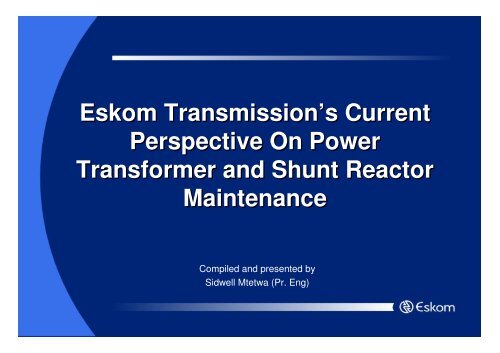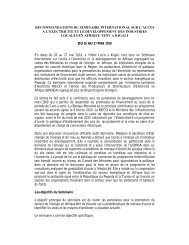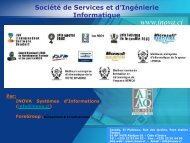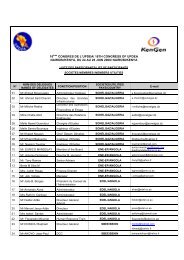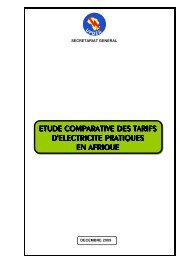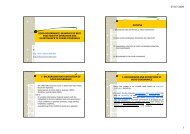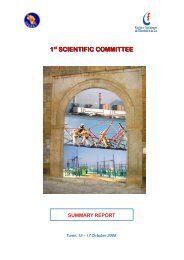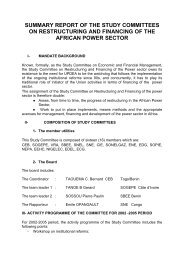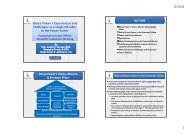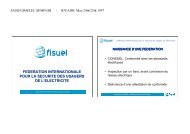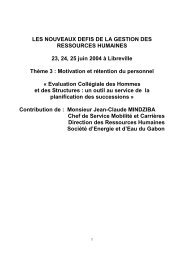Transmission Perspec..
Transmission Perspec..
Transmission Perspec..
You also want an ePaper? Increase the reach of your titles
YUMPU automatically turns print PDFs into web optimized ePapers that Google loves.
Eskom <strong>Transmission</strong>’s Current<br />
<strong>Perspec</strong>tive On Power<br />
Transformer and Shunt Reactor<br />
Maintenance<br />
Compiled and presented by<br />
Sidwell Mtetwa (Pr. Eng)
Contents<br />
• Definitions<br />
• <strong>Transmission</strong> Network Overview<br />
• Challenges<br />
• Strategies<br />
• Summary
“The The days of our lives are seventy years; and if by<br />
reason of strength they are eighty years, Yet their<br />
boast is only labour and sorrow; For it is soon cut off<br />
and we fly away.”<br />
Psalms 91:10<br />
Life is finite, no matter what.
“The The days of our lives are forty years; and if by reason<br />
of good maintenance they are fifty years, Yet their<br />
significance is only availability and outage; For it is<br />
soon cut off and we are scrapped.”<br />
Life Cycle Management Plan
Definitions<br />
Maintenance<br />
• The act of keeping an asset in good condition to<br />
perform efficiently and safely the service for<br />
which it is used.<br />
Maintenance Philosophy<br />
• What action to do and when to do it<br />
TMP – <strong>Transmission</strong>’s Maintenance Philosophy
<strong>Transmission</strong> Network’s Overview<br />
• <strong>Transmission</strong> has 155 substations with an incoming<br />
voltage of either 132, 220, 275, 400 or 765 kV<br />
• Substations are grouped in 8 grids / regions<br />
• There are 510 Power Transformers ( >125GVA)<br />
• 135 additional transformers planned ( installed by<br />
2017)<br />
• The present average age of this transformer fleet is<br />
28 years
<strong>Transmission</strong> Network’s Overview<br />
• About 80 Shunt Reactors (> 7 GVAr)<br />
• 45 additional shunt reactors required by 2017<br />
• The average age of <strong>Transmission</strong>’s reactor fleet is<br />
24 years<br />
• 33 different OEMs for transformers and reactors<br />
• 21 different tap changer OEMs
Q u a n t it y<br />
180<br />
160<br />
140<br />
120<br />
100<br />
80<br />
60<br />
40<br />
20<br />
0<br />
<strong>Transmission</strong> Network’s Overview<br />
<strong>Transmission</strong> Tapchangers By Make<br />
ABB<br />
AEG<br />
AEI<br />
Alsthom<br />
Ansaldo<br />
ASEA<br />
Asgen<br />
ATC<br />
D esta<br />
Elin<br />
Eng Elec<br />
Ferranti<br />
Fuji<br />
Fuller<br />
H aw ker Sid<br />
M itsubishi<br />
Osaka<br />
MR<br />
Toshib a<br />
Trafo U nion<br />
U nknown<br />
Manufacturers<br />
Series1
TMP - Challenges<br />
1. Unavailability of plant for long outages.<br />
• Maintenance engineers – ensure LTPH and<br />
safety.<br />
• Plant operators – security of supply and safety.<br />
2. In carrying out maintenance<br />
– Not enough time.<br />
– Lack of skilled people – risk of further outage<br />
– Lack of OEM support on certain old makes
TMP - Challenges<br />
3. On line processes are insufficient to keep the<br />
plant in service for very long time. Offline<br />
interventions are needed
TMP – Plant Availability<br />
• Network was built with redundancy<br />
• Economic growth exceeded the expectations<br />
• Redundancy no longer existing in some<br />
substations<br />
• During outage – increased risk of failure<br />
(loading / age)<br />
• Some units have conditional avail ability<br />
(fixed tap pos.)
TMP - Skills<br />
• Skills are becoming harder to mature and to<br />
retain<br />
• OEM training is expensive (overseas)<br />
• Lack of extensive exposure after training<br />
• OEM trained staff are quickly recruited in the<br />
private sector
TMP – Skills<br />
• Staff not trained by OEM’s, performing intrusive<br />
work - risk of failure<br />
• Wide spectrum of types installed in the network<br />
• OEMs are no longer in business<br />
• OEMs still in business - designs were<br />
discontinued
Incident No.1 – Near Miss<br />
• A 15MVA 132/33kV transformer was taken out of service<br />
for a scheduled tap changer maintenance during a<br />
weekend. When the maintenance was completed, the<br />
transformer was re-commissioned and put back on load.<br />
Minutes after taking load, smoke was seen coming out of<br />
the diverter chamber of the transformer.<br />
• The investigation revealed that the transition resistors<br />
were heating the oil, because the resistors were<br />
continually in the circuit due to incorrect wiring.
Incident No.2 – Reduced Capability<br />
• A 500MVA 275/132/22kV autotransformer was taken out of<br />
service for a scheduled tap changer maintenance over a<br />
weekend. This transformer had a design where the diverter is<br />
physically sitting on top of the 132kV bushing. During<br />
inspection, problems were identified on the diverter switches.<br />
• Instead of removing only the diverter switch, the contractor<br />
removed the complete set of bushing and diverter. In attempting<br />
to re-install, the equipment was mishandled and the bushing got<br />
damaged. No spares could be found for this old design.<br />
• The transformer was then modified to run on a fixed tap<br />
position.
Incident No.3<br />
A 145MVAr 765kV Shunt reactor was taken out of<br />
service for maintenance. A person supposed to<br />
clean the pressure relief valve removed the PRV<br />
and oil gushed out.
TMP - Challenges<br />
• All these bring about a complex situation and<br />
<strong>Transmission</strong> has to manage it for continuity of supply.<br />
• If maintenance is correctly/timeously done – benefits<br />
• If maintenance is incorrectly/not done - consequences
TMP - Challenges
TMP - Challenges<br />
Eskom <strong>Transmission</strong> considers precise<br />
maintenance philosophy combined with proper<br />
strategies is the key in managing all these<br />
challenges
TMP - Strategies<br />
<strong>Transmission</strong> maintenance philosophy is built with<br />
the following strategies<br />
1. Specify and use low maintenance technologies<br />
• Vacuum tap changers – 300 000 ops<br />
• Welded main covers – no gasket leaks<br />
• RIP bushings – no bushing oil leaks<br />
• Online dryers – preserve paper insulation<br />
• Conservator air bags – eliminate oil oxidation.
TMP - Strategies<br />
Oil tap<br />
Conservator with air bag
TMP - Strategies<br />
RIP bushings with SiR sheds OIP bushing with porcelain sheds
TMP - Strategies<br />
Oil leak on main lid gasket<br />
On line moisture remover
TMP - Strategies<br />
2. Maintenance - as per OEM instruction or 6 yearly<br />
(synchronized with breaker maintenance)<br />
3. Only accredited persons to do intrusive work.<br />
4. Only people trained by OEMs and have post<br />
training experience are accredited
TMP - Strategies<br />
5. Standardizing on components e.g. tap changers<br />
(difficult to keep spares for all types)<br />
6. Repair non OEM supported units using existing<br />
classical supplier for parts or use local suppliers<br />
7. Detailed and frequent inspections<br />
8. Inspection and maintenance records are kept in<br />
an electronic database
TMP - Strategies
TMP - Strategies
TMP - Strategies<br />
Experience has shown us that only OEM trained<br />
technicians with suitable post training experience<br />
can be accredited to perform intrusive<br />
maintenance
Summary<br />
• Asset reliability is a function of maintenance<br />
• <strong>Transmission</strong>’s challenges with maintenance are<br />
– Non availability of plant for outage<br />
– Scarcity of skilled people<br />
– Many OEMs are no longer in business – no<br />
spares<br />
– Some old designs have been discontinued –<br />
no support<br />
– Wide spectrum of component types
Summary<br />
• Strategies that have been developed are<br />
– Use of no / low maintenance technologies<br />
– Maintenance as per OEM instruction or 6 yearly<br />
– Only accredited technicians to do intrusive work.<br />
– Only people trained by OEMs and have post training<br />
experience are accredited<br />
– Standardizing on components like tap changers<br />
– Get specs and manufacture components locally – quality<br />
risk. Else do modifications
Maintenance Categories<br />
• <strong>Transmission</strong> maintenance is categorized in<br />
three types<br />
1. Short term maintenance<br />
2. Medium term maintenance<br />
3. Long term maintenance
Thank Thank Thank Thank Thank You You<br />
You<br />
You<br />
You<br />
Questions and Comments


